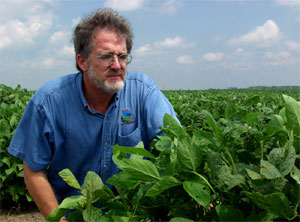Fayetteville, Arkansas
March 1, 2006
Arkansas dodged the bullet of
Asian soybean rust in 2005, but
University of Arkansas Division of Agriculture scientists
aren’t letting their guard down for 2006.
To meet the threat of soybean rust, the Division of Agriculture
established the Asian Soybean Rust Working Group, a coalition of
scientists working in cooperation with the USDA Animal and Plant
Health Inspection Service, the Arkansas State Plant Board,
soybean producers and industries.
The working group is attacking the problem along multiple
avenues to protect the state’s soybean crop, said plant
pathologist Rick Cartwright.
 |
|
Plant pathologist John
Rupe is part of the Asian Soybean Rust Working Group, a
coalition of University of Arkansas Division of
Agriculture scientists working in cooperation with the
USDA Animal and Plant Health inspection Service, The
Arkansas State Plant Board, soybean producers and
industries to minimize the risk of soybean rust in
Arkansas. |
Soybean rust is caused by a
fast-moving fungus that infects the leaves of soybeans and a few
other plants and, if not controlled, can severely reduce yields,
said plant pathologist John Rupe.
Because it requires a living host, Asian soybean rust can’t
survive over winter in Arkansas, Rupe said. “It has a wide range
of hosts, including kudzu, but all its hosts lose their leaves
during the winter.”
That means soybean rust has to over-winter in warmer climates
and blow in on the wind, Rupe said. In 2004, rust arrived in
Arkansas on the winds of hurricane Ivan, but too late to affect
the soybean crop. In 2005, it was found mostly in the panhandle
of Florida and the southern areas of Georgia, Alabama and
Mississippi. It also was found very late in the season in some
kudzu plants in Kentucky and Texas.
Much of the working group’s effort is directed at early
detection. Rupe said sentinel plots are planted about a month
earlier than the soybean crop.
“Rust is difficult to detect in its early stages,” Rupe said.
“It likely starts off slowly in the lower leaves where it’s
difficult to see, then really takes off during the reproductive
stage, the most critical time for establishing yield. Early
planting of the sentinel plots gives us about a month’s head
start to apply fungicides and prevent serious damage to the
crop.”
Samples from the sentinel plots are inspected in Division of
Agriculture labs in Fayetteville, Lonoke, Hope and Monticello,
said soybean agronomist Chris Tingle.
Rupe said spore traps are also being tested as a means of early
detection.
“Collectors send us sample slides from spore traps throughout
the South,” he said. “We read those slides for spores that look
like soybean rust, and that can give us clues about where to
look for it and possibly find it early.
“In South America, spore traps work really well, even detecting
rust before the sentinel plots,” Rupe said.
Division scientists are looking for other means of protecting
Arkansas soybeans, Rupe said.
“We’re looking for soybean varieties that exhibit resistance,
which can be developed into improved varieties,” Rupe said.
“We’re also conducting basic fungicide research to determine the
best timing for application and to determine how late plants can
be treated effectively after infection begins.”
Another avenue of research uses genetic tests on rainwater to
see if rust DNA can be detected upon arrival.
“Storms are the means by which soybean rust spores move from one
area to another,” Rupe said. “Then it spreads locally on the
wind.”
Tingle said all research and detection findings are reported
weekly to the USDA database. “Producers can go to the
USDA soybean rust Web site
to monitor progress of soybean rust scouting and detection by
county.” |